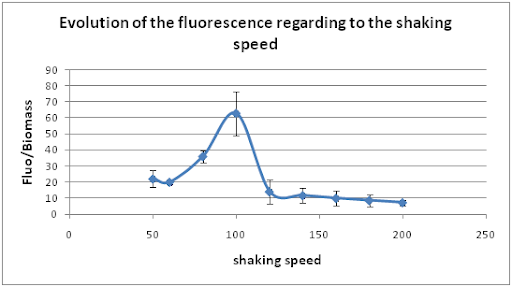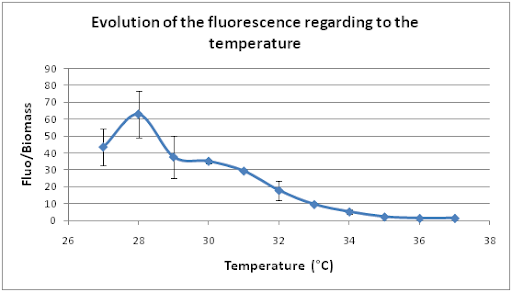Difference between revisions of "Part:BBa K342000:Experience"
(→Applications of BBa_K342000) |
(→Applications of BBa_K342000) |
||
| (3 intermediate revisions by 2 users not shown) | |||
| Line 4: | Line 4: | ||
===Applications of BBa_K342000=== | ===Applications of BBa_K342000=== | ||
| − | This part is a promoter sensible to temperature, shaking speed and osmotic pressure. It is an inductible promoter which best rate of expression is obtained with | + | <html> |
| + | This part is a promoter sensible to temperature, shaking speed and osmotic pressure. It is an inductible promoter which best rate of expression is obtained with these conditions: <br/> | ||
<li> temperature : 28°C | <li> temperature : 28°C | ||
<li> shaking speed : 100 rpm | <li> shaking speed : 100 rpm | ||
| − | <li> osmotic pressure : 0,01 M | + | <li> osmotic pressure : 0,01 M (sucrose) |
| − | + | ||
| − | + | ||
| − | + | ||
<br/> | <br/> | ||
| + | <br/> These three values are based on three experiments measuring Fluorescence/Biomass. Curli promoter activation is estimated using a <i>gfp</i> reporter gene, by varying the three parameters: shaking speed, temperature and osmolarity. | ||
| + | <br/><br/> | ||
| + | <h4>Influence of the shaking speed</h4> | ||
| + | <br> | ||
| + | <div style="text-align:center; float:right; margin-left:20px; margin-top:-50px;"> | ||
| + | <img class="image1" src="http://lh6.ggpht.com/_Uc3bmii-yi0/TMir7M69RpI/AAAAAAAAAsY/p17peKPRk3Q/graphS.png" title="Shaking speed" alt="Shaking speed"/> | ||
| + | </div> | ||
| + | |||
| + | <p>First of all, cultures were in a waterbath at 28°C and only the shaking speed was changed. We have tried 9 different shaking speeds from 50 to 200 rpm.</p> | ||
| + | |||
| + | <br><br> | ||
| + | <p>The curve shows that our system presents the nice property to have an optimal shaking speed at 100 rpm when the temperature is 28°C. <br clear="all"> | ||
| + | <br> | ||
| + | <br></p> | ||
| + | |||
| + | <h4>Influence of the temperature</h4> | ||
| + | <br> | ||
| + | <div style="text-align:center; float:right; margin-left:30px; margin-top:-20px;"> | ||
| + | <img class="image1" src="http://lh4.ggpht.com/_Uc3bmii-yi0/TMiozJLDxrI/AAAAAAAAAr0/qCRhz7rj0Vo/graphT.png" title="Shaking speed" alt="Shaking speed"/> | ||
| + | </div> | ||
| + | <p>The next series of cultures were in a waterbath with a shaking speed of 100 rpm and we modified the temperature from 27°C to 37°C, degree by degree.</p> | ||
| + | <br> | ||
| + | |||
| + | <p> | ||
| + | The optimal temperature seems to be 28°C. So our system presents also an optimal response according to the temperature. | ||
| + | For both series of measurements, GFP fluorescence was very low, while the shaking speed and the temperature were high. Notably, when the temperature is higher than 36°C, the GFP fluorescence is the same as the negative control. | ||
| + | <br><br><br><br> | ||
| + | </p> | ||
| + | |||
| + | <h4>Influence of the osmotic pressure</h4> | ||
| + | <br> | ||
| + | <div style="text-align:center; float:right; margin-left:30px; margin-top:-20px;"> | ||
| + | <img class="image1" src="http://lh4.ggpht.com/_Uc3bmii-yi0/TMipfu7ZAvI/AAAAAAAAAr8/YmLjdyPp8Gk/graphosm.png" /> | ||
| + | </div> | ||
| + | <p> | ||
| + | Then, we studied the influence of osmotic pressure on our promoter. We modified the osmotic pressure by changing the sucrose concentration of the culture media. We chose 5 different concentrations in sucrose : 0M - 0,01M - 0,05M - 0,1M – 0,5M. The samples were incubated at 28°C with a shaking speed of 100rpm (previous optimal conditions). | ||
| + | </p> | ||
| + | <br> | ||
| + | |||
| + | <p>We deduced from this curve that when the osmotic pressure is decreased, the promoter Curli is less active.</p><br><br><br><br clean="all"> | ||
| + | |||
| + | <p> | ||
| + | In conclusion, the Curli promoter is very responsive at different conditions of culture: shaking speed, temperature and osmotic pressure. Indeed, a gene under the Curli promoter control can be switched ON or OFF by acting on temperature or speed shaking or osmotic pressure. This system is so very versatile and can respond to different environmental signals. | ||
| + | |||
| + | </p> | ||
| + | |||
| + | </html> | ||
===User Reviews=== | ===User Reviews=== | ||
Latest revision as of 20:09, 5 November 2010
This experience page is provided so that any user may enter their experience using this part.
Please enter
how you used this part and how it worked out.
Applications of BBa_K342000
This part is a promoter sensible to temperature, shaking speed and osmotic pressure. It is an inductible promoter which best rate of expression is obtained with these conditions:
These three values are based on three experiments measuring Fluorescence/Biomass. Curli promoter activation is estimated using a gfp reporter gene, by varying the three parameters: shaking speed, temperature and osmolarity.
Influence of the shaking speed

First of all, cultures were in a waterbath at 28°C and only the shaking speed was changed. We have tried 9 different shaking speeds from 50 to 200 rpm.
The curve shows that our system presents the nice property to have an optimal shaking speed at 100 rpm when the temperature is 28°C.
Influence of the temperature

The next series of cultures were in a waterbath with a shaking speed of 100 rpm and we modified the temperature from 27°C to 37°C, degree by degree.
The optimal temperature seems to be 28°C. So our system presents also an optimal response according to the temperature.
For both series of measurements, GFP fluorescence was very low, while the shaking speed and the temperature were high. Notably, when the temperature is higher than 36°C, the GFP fluorescence is the same as the negative control.
Influence of the osmotic pressure

Then, we studied the influence of osmotic pressure on our promoter. We modified the osmotic pressure by changing the sucrose concentration of the culture media. We chose 5 different concentrations in sucrose : 0M - 0,01M - 0,05M - 0,1M – 0,5M. The samples were incubated at 28°C with a shaking speed of 100rpm (previous optimal conditions).
We deduced from this curve that when the osmotic pressure is decreased, the promoter Curli is less active.
In conclusion, the Curli promoter is very responsive at different conditions of culture: shaking speed, temperature and osmotic pressure. Indeed, a gene under the Curli promoter control can be switched ON or OFF by acting on temperature or speed shaking or osmotic pressure. This system is so very versatile and can respond to different environmental signals.
User Reviews
UNIQe3ba18f95b31873c-partinfo-00000001-QINU UNIQe3ba18f95b31873c-partinfo-00000002-QINU
